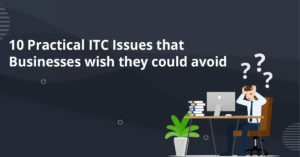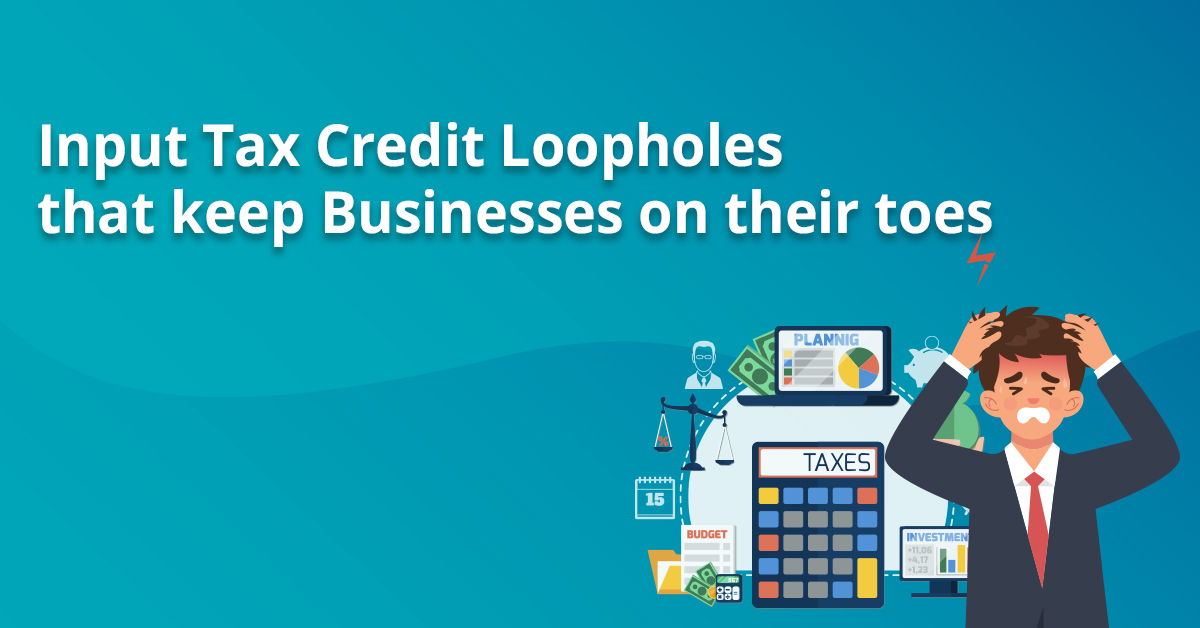10 Issues in ITC under GST that have businesses on their knees
ITC or Input Tax Credit under GST is the process of claiming the credit of taxes already paid by a taxpayer as an input in the making of a good or service.
Although it has been a while since ITC has been in the GST regime it still has many issues that the taxpayers face on a regular basis.
In this article, we shall address the working of input tax credit & then a few of these issues in ITC under GST
Input Tax Credit under GST
Input Tax Credit under GST is the tax that you paid as an input while making a finished good or service.
Since you paid the tax earlier you will not have to pay the same tax again on the finished goods or service.
Thus you will be allowed to take credit for such input taxes that you can utilize to discharge your outward tax liabilities.
For example, if you paid Rs. 5000 in raw material while manufacturing shoes and you have a tax liability of Rs. 10,000 on the finished good (the shoes), then you can claim the credit of the tax that you already paid as an input, and adjust it with your tax liability.
After adjusting you will only be liable to pay Rs. 5000 as the rest has already reached the government through the supplier of your raw material.
Working, Availment & Utilization of ITC under GST
Availing ITC can be tricky business as new provisions and changes are introduced every day under the GST regime.
There are multiple rules & restrictions in the working, availment & utilization of ITC under GST.
ITC can be claimed on any goods and services that have been purchased, solely with the purpose of business, unless stated otherwise.
But the government has stated multiple cases & scenarios where the ITC remains blocked. Thus bifurcating ITC into eligible & ineligible (blocked) ITC.
The taxpayers will not be able to claim the blocked ITC and even if they have, they will have to reverse the ITC into their outward tax liabilities, with or without interest.
Now, these cases are very specific & there are no exceptions in the same.
Here is a list of a few cases of Blocked ITC.
- Goods purchased for personal use
- Memberships of gym, health clubs, beauty salons, etc.
- Catering for parties
- Motor Vehicle & maintenance
- Insurance
- Work Contract
- Purchase from Composition Dealers
- Free Samples/Gifts/Destroyed, lost or stolen goods
Click here to see all the ineligible cases of ITC with exceptions.
This may look simple that the government has specified a few cases & ITC shall not be available for the same, but when it comes to practical application, that’s where the problem begins.
Every case is unique, and in practical life, there can be n number of such cases in one single unit of business. How to understand the applicability then?
Additionally, the government keeps adding new changes while the rules & applicability remains to be vague.
But then again, the government demands accuracy, so when you make mistakes, you will be charged with interests & even notices.
This makes ITC & its compliance a very difficult task for businesses & accountants. Very deep knowledge of all the existing as well as new rules & provisions is required in order to make the ITC compliance perfect.
Then comes the utilization of credits, which is again complicated.
Refer to the table below to know, how the utilization of ITC works-
| S. No. | Credit type | Primary Utilization | Secondary Utilization |
| 1. | CGST | CGST | IGST (cannot be utilized for SGST/UTGST) |
| 2. | IGST | IGST | CGST, then SGST/UTGST |
| 3. | SGST/UTGST | SGST/UTGST | IGST |
So, it is clear from the table that a certain type of GST credit can only be used to release a certain type of tax liability.
But let’s take an example-
Since CGST credits can only be utilized to pay either CGST or IGST, what happens to the credit that is left after releasing the tax liability completely?
You will have to carry forward that credit into the next tax period, as you cannot pay SGST using the CGST credits.
This is a complicated rule, & is the root of multiple accounting mistakes.
10 Practical Issues with ITC that all businesses face

There are multiple issues that the businesses face regularly while calculating & availing the Input Tax Credit. These issues are the result of too many yet vague restrictions & rules put in place to make the provision more accurate.
However, instead of serving the purpose of easing things, ITC makes the work even more difficult for taxpayers & accountants. But using GSTR 2A Reconciliation Software businesses can claim upto 100% ITC.
As accuracy is the key, you will always have to keep the rules under ITC handy.
But no matter how precise you try to be, small errors may still arise maybe because every individual has a different understanding of a matter.
Here, we have picked out a few, most common issues that taxpayers face in ITC under GST, but the list still goes on as every situation is unique having specified circumstances.
- Claiming under the wrong head- Claiming the credit under the wrong GST head is a very common and genuine mistake. But it can cost you interests & reversal of ITC. Thus, make sure that you claim the credit of taxes under the correct headers only.
- Issues in the claim & utilization of SGST- Availing & utilizing SGST is a challenging job & requires precision as the SGST differs for each state. Also, there are restrictions on claiming the SGST of one state, if you are registered in another state. Meaning if you paid the SGST of Karnataka but are registered in Maharashtra, you cannot claim & utilize the Karnataka credit for releasing the tax liabilities of Maharashtra. However, you can utilize the Karnataka SGST Credit to release the tax liability of SGST of Karnataka. This is very twisted & in a way violates the agenda of GST.
- Wrong Place of supply- If your business is established in Maharashtra but you received the goods in your Gurgaon warehouse, the place of supply will be Gurgaon & not Maharashtra. In the example above, you must claim the SGST as per Gurgaon, which is the actual place of supply.
- Receipt of Goods- In order to claim ITC you must receive the goods completely, as per the rule. But how will you prove that you have received the goods fully? Through your accounts & through the supplier’s records, invoices, e-Way Bills, etc.
- Issues with ITC reversals- There are multiple cases where you will have to reverse the ITC along with interest. Since there are so many new rules, it is common to deem an ineligible ITC for an eligible one. But this error can cost you penalties as you claimed the ITC that you were not eligible for.
- ITC reversal on disposal of assets & Capital goods- The life of assets & capital good is specified to be minimum of 5 years, but if you dispose of such goods or sell them before this period you will have to reverse the ITC that you claimed on the purchase of such goods.
- ITC on samples, stolen, damaged goods- You will have to reverse the ITC that you claimed on inputs in the making of samples, gifts, stolen, damaged & lost good since you didn’t actually sell those goods you will not be allowed to claim the credits for the same. This rule is clearly a loss for businesses, although samples are part of the marketing strategy.
- Failure to pay within 180 days- You will have to reverse the ITC if you fail to make the full payment within 180 days from the date of the invoice.
- Timeline to claim ITC under GST- The government has specified & fixed a time limit to claim the credits, beyond which your credit will lapse & you won’t be able to avail or use them. This creates additional pressure on businesses & accountants.
- Vendor Compliance- You must ensure that the tax paid by you to the supplier reaches the government. Meaning your supplier must file their GST returns & release their tax liabilities, only then will you be able to claim the credit of the same. But, the issue here is, you cannot control the actions of your supplier, you can only notify them or pursue them to be compliant, but their actions may not be in your hand.
Conclusion
So, ITC under GST is not as easy as it seems, & requires precision & knowledge. Although manual errors are always present and are quite common. About the Author– GSTHero– Making GST Simple! GSTHero is the best GST filing, e-Way Bill Generation & E Invoicing Software in India. GSTHero is a government authorized GST Suvidha Provider. Both Businesses and Tax Practitioners can file GSTR 1, GSTR 3B, GSTR 9 and GSTR 9C with all supporting reports. 1 Click Auto Reconciliation & report-matching feature helps you in claiming up to 100% ITC and finds your GST Defaulting Suppliers. GSTR2A vs GSTR-3B, GSTR-1 vs GSTR-3B, ‘GSTR-1, GSTR-2A & GSTR-3B’ annual report matching is also provided by GSTHero.
About the Author– GSTHero– Making GST Simple! GSTHero is the best GST filing, e-Way Bill Generation & E Invoicing Software in India. GSTHero is a government authorized GST Suvidha Provider. Both Businesses and Tax Practitioners can file GSTR 1, GSTR 3B, GSTR 9 and GSTR 9C with all supporting reports. 1 Click Auto Reconciliation & report-matching feature helps you in claiming up to 100% ITC and finds your GST Defaulting Suppliers. GSTR2A vs GSTR-3B, GSTR-1 vs GSTR-3B, ‘GSTR-1, GSTR-2A & GSTR-3B’ annual report matching is also provided by GSTHero.
GSTHero ERP Plugins provide 1 Click e-Way Bill & E-Invoice, Generation, Operation & Printing from your own ERP like Tally, SAP, Marg, Busy, Microsoft Dynamics, Oracle & others itself with high data security

